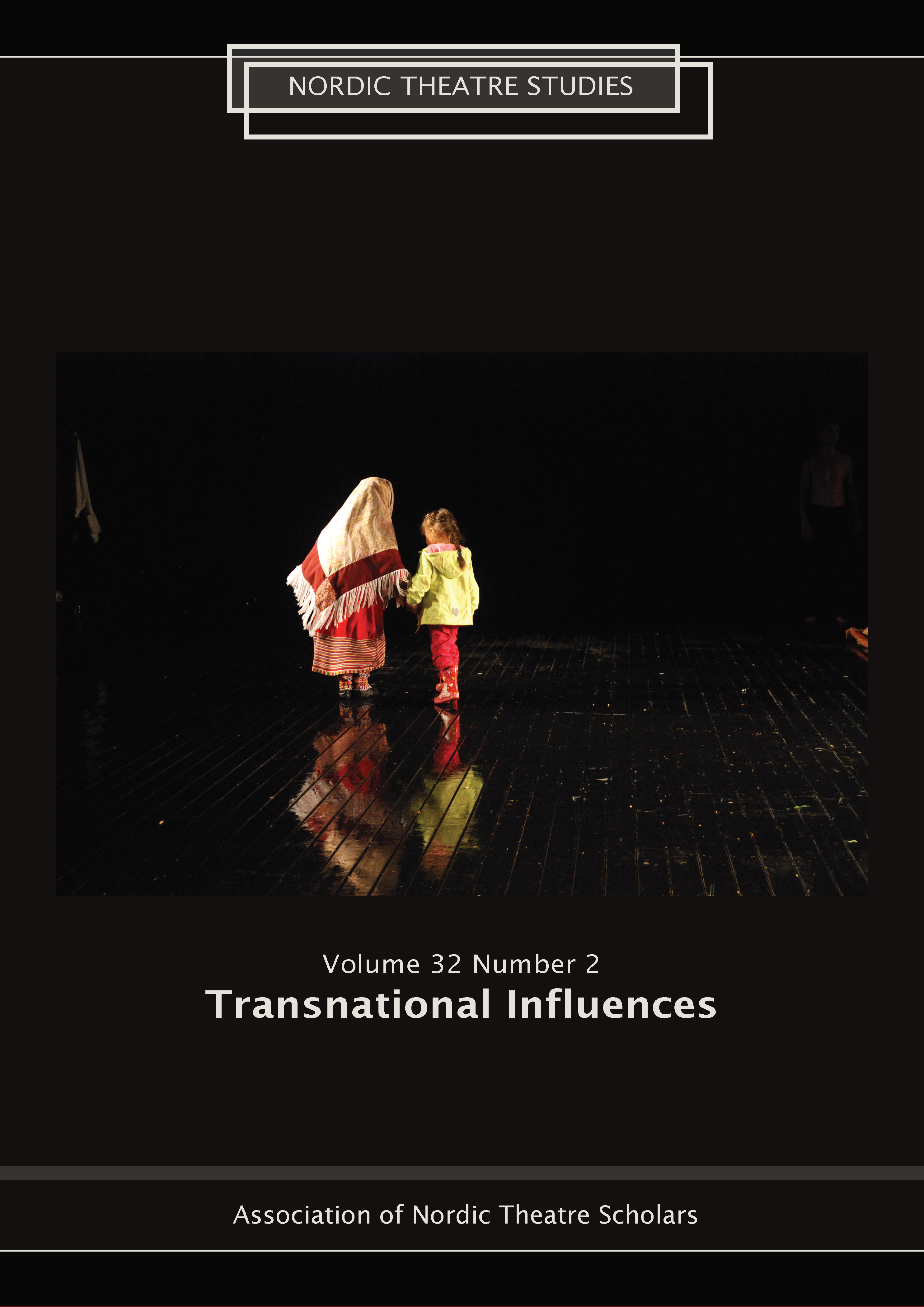Performing Nordic White Femininity
Two Swedish Divas in the U.S. in the Nineteenth Century
DOI:
https://doi.org/10.7146/nts.v32i2.124348Keywords:
Diva, nordic white femininity, performances of Swedishness, race, class, critical whiteness theories, nineteenth century, touring the U.S., Jenny Lind, Christina NilssonAbstract
This study is an intersectional investigation of how the first two international Swedish superstars, Jenny Lind (1820–1887) and Christina Nilsson (1843–1921), performed gender, race, nationalism, and class during their respective tours of the United States of America in 1850–1852 and 1870–1872. The purpose is to chart early transatlantic performances of Nordic white femininity and Swedishness as well as to discuss the symbolical values and associations that it signaled. I will argue that Lind and Nilsson set out a template of idealized Nordic white femininity in the U.S. and that they contributed to the growing identity and self-awareness of Swedish-Americans.
References
Benson, James E., and Lloyd F. Thompson. 2001. The Swedes of Greater Brockton. Charleston, S.C.: Arcadia Publishing.
Blanck, Dag. 2014. ”’A Mixture of People with Different Roots’: Swedish Immigrants in the American Ethno-Racial Hierarchies.” Journal of American Ethnic History 33:3, 37–54.
Davis, Tracy C. 2012. ”From Diva to Drama Queen.” In Rachel Cowgill & Hilary Poriss (eds.). The Arts of the Prima Donna in the Long Nineteenth Century. Oxford: Oxford University Press, 252–271.
Dunsmore, Sarah Jenny. 2015. Jenny Lind: the story of the Swedish nightingale. [Unknown]: RedDoor.
Dyer, Richard. 1997. White: essays on race and culture. London: Routledge.
Horak, Laura. 2014. ”Queer Crossings: Greta Garbo, National Identity, and Gender Deviance.” In Jennifer Bean, Anupama Kapse & Laura Horak (eds.). Silent Cinema and the Politics of Space. Bloomington, Indiana: Indiana University Press, 270–294.
Jakobson, Matthew Frye. 1998. Whiteness of a different color: European immigrants and the alchemy of race. Cambridge, Mass.: Harvard University Press.
Kellogg-Strakosch, Clara Louise. 1913. Memoirs of an American prima donna. New York: Putnam.
Koestenbaum, Wayne. 2001. The Queen’s Throat: Opera, Homosexuality, and the Mystery of Desire. New York: Da Capo.
Kunhardt jr, Philip B., Philip B. Kunhardt III, and Peter W. Kunhardt. 1995. P. T. Barnum: America’s Greatest Showman. New York: Alfred A. Knopf.
Laurin, Carl G. 1910. Skämtbilden och dess historia. Stockholm: P. A. Nordstedt & söner.
Ling, Jan. 1978. Svensk folkmusik. Stockholm: Bokförlaget Prisma.
Linscott, Robert N. 1959. Selected Poems and Letters of Emily Dickinson. New York: Anchor Books, Random House.
Lundström, Catrin. 2010. ”Transnationell vithet: Svenska migrantkvinnor i USA och Singapore.” Tidskrift för genusvetenskap 1–2/2010, 25–45.
Mitchell, Katharine, and Clorinda Donato. 2015. “The Diva in Modern Italian Culture.” Italian Studies 70:3, 293–297, DOI 10.1179/0075163415Z.000000000102.
Montemorra Marvin, Roberta. 2012. ”Idealizing the Prima Donna.” In Rachel Cowgill and Hilary Poriss (eds.). The Arts of the Prima Donna in the Long Nineteenth Century. Oxford: Oxford University Press, 21–41.
Ohlsson, Hélène. 2020. “Diva.” Lambda Nordica 25:1, 38–42, https://doi.org/10.34041/ln.v25.611.
Ohlsson, Hélène. 2018. ”Rivaling femininities – Jenny Lind and Emélie Högqvist, The emergence of multiple femininities and female identity.” European Romantic Review 29:1, 63–77, https://doi.org/10.1080/10509585.2018.1416997.
Parker Willis, Nathaniel. 1851. The Life of Jenny Lind. Philadelphia: Robert E. Peterson.
Poriss, Hillary. 2012. ”Prima Donnas and the Performance of Altruism.” In Rachel Cowgill and Hilary Poriss (eds.). The Arts of the Prima Donna in the Long Nineteenth Century. Oxford: Oxford University Press, 42–60.
Rosenberg, Tiina. 2009. Bögarnas Zarah diva, ikon, kult. Stockholm: Normal förlag.
Skeggs, Beverly. 2001. “The Toilet Paper: Femininity, Class and Mis-Recognition.” Women’ Studies International Forum 24.3/4, 295–307.
Straub, Kristina. 1992. Sexual Suspects: Eighteenth-Century Players and Sexual Ideology. Princeton: Princeton University Press.
Tjeder, David. 2003. The power of character: middle-class masculinities, 1800–1900. Diss. Stockholm: Stockholm University.
Tägil, Ingela. 2020. Näktergalen: en biografi över Jenny Lind. Stockholm: Natur & Kultur.
Tägil, Ingela. 2013. Jenny Lind: röstens betydelse för hennes mediala identitet: en studie av hennes konstnärsskap 1838-49. Diss. Örebro : Örebro universitet.
Warner, Marina. 1994. From the beast to the blonde: on fairy tales and their tellers. London: Chatto & Windus.
Newspapers and magazines
s.n. 1850. “Stockholm.” Carlshamns Allehanda 14.11.1850.
s.n. 1870. ”Christina Nilsson i Newyork.” Lunds Veckoblad 15.10.1870.
s.n. 1870. “Ur en korrespondens från Philadelphia.” Malmö Allehanda 30.11.1870.
s.n. 1870. ”Christinæ kyrka.” Amerika 30.12.1870.
s.n. 1870. ”Christina Nilsson i Boston.” Amerika 30.12.1870.
s.n. 1873. ”Wåra landsmän i Amerika.” Nya Wermlandstidningen 24.12.1873.
Downloads
Published
How to Cite
Issue
Section
License
The copyright belongs to the authors and Nordic Theatre Studies. Users can use, reuse and build upon the material published in the journal but only for non-commercial purposes. Users are allowed to link to the files, download the files, distribute the files on a local network (preferably by links), upload the files to local repositories if their institutions require them to do so, but not republish the files without proper agreements with the journal and the author.

